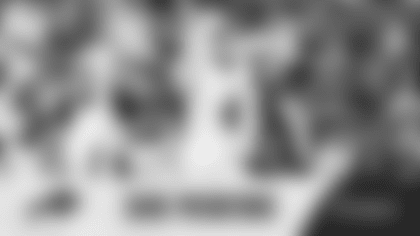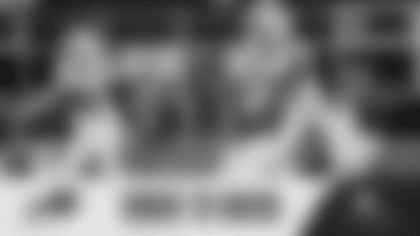Through the first four games of the 2010 season, Buffalo's third down defense was in a word abysmal. Ranking 31st in the league, the Bills were allowing opponents to convert on third down a whopping 51 percent of the time. It led to long drives for the opposition, a big disparity in time of possession and of course points on the board.
Over the last three games however, that trend has changed dramatically for the better as Buffalo has held their opponents significantly below the league average (38%).
In Week 5 Buffalo held Jacksonville to a 36 percent success rate (4-11) on third down. That was followed by a 2-11 conversion day (18%) for Baltimore in Week 6, a season best for the Bills defense. Last Sunday Buffalo's defense again was stout on third down permitting just four conversions on 15 attempts (27%) at Kansas City.
"In the past when we've been in those situations we've let it get away from us," said Kyle Williams. "We didn't make a play when we needed to make a play and teams would run the clock out on us. The last couple of weeks we've been able to get the ball back and give us an opportunity to win. I definitely think it's progress. Any time you're putting your offense or special teams in a position to win a football game it's progress."
In three short weeks the Bills defense has shaved their third down conversion percentage allowed by 10 percent from 51% after Week 4 to 41% after Week 8.
So what has led to this dramatic change for the better?
For one Buffalo has improved their pass rush. Through the first four games this season the Bills had just four sacks. In their last three outings they have almost doubled that amount with seven. Four of those sacks have come on third down.
"We're getting a little bit better pressure on the passer on third downs," said head coach Chan Gailey. "I think we're understanding what the other team likes to do in third down a little bit better. So that's been a real plus and a real positive. That's something that you can build on."
Those four third down sacks over the last three games came in third and medium (3rd-and-4 to 3rd-and-7) to third and long (3rd-and-8 or more) situations over the past three games. Naturally a defense can get more aggressive when it's a more obvious passing situation for the offense.
"When we've had our opportunities to do it we've taken advantage of it," said Dwan Edwards. "We're getting some second and long, third and long opportunities where we know it's pass and can get after teams a little bit."
But where Buffalo's defense has made its biggest improvement is on third and short. In their last three outings the Bills have been exceptional in getting stops on third and short situations (3rd-and-1 to 3rd-and-3).
In the 12 instances where their opponents have been in 3rd-and-3 or less over the past three games, Buffalo has allowed them to move the chains just three times (3-12, 25%). In fact their ability to stop opponents on third and short the past three games has been better than on third and medium (33%) though that too is better than the league average.
"Everyone wants to just line up and run right at us," said Paul Posluszny. "When it comes to that we've got great guys up front, solid D-linemen that can take on a block and get off and make a play. Even though that's such a small area and portion of the game that (statistic) shows when it comes down to it and they want to stand toe to toe with us we can handle the physical part of it."
Still, the most impressive trend for Buffalo's third down defense over the last three games is what they've done come the fourth quarter. Since Week 5, the Bills have not allowed a third down conversion in the fourth quarter or in overtime (0-14).
"That's kind of what we've been trying to build on since Baltimore," said Edwards. "We stepped up and gave our offense opportunities to make stuff happen. We didn't get it done, but it feels good to keep us in the game. We feel like we're not blowing it for our team."
The last time Buffalo permitted a third down conversion in the fourth quarter was when Mark Brunell subbing in for Mark Sanchez completed a seven-yard pass to Ben Hartsock to convert a 3rd-and-4 in Buffalo's Week 4 loss to the Jets.
Even in the second half overall Buffalo's third down defense has been downright stingy over the last three games, allowing just three conversions on 20 attempts (15%).
So although the Bills are still surrendering a great deal of yardage in games, their improved third down defense, particularly in the fourth quarter is making a difference when it comes to the scoreboard. Buffalo has allowed just 12 fourth quarter points in the last three games and just a field goal in the last two outings.
"If you're good on third down and get them to third down enough times you can get them off the field," said Gailey. "We were fortunate enough to be able to do that and hold their offense down in points."
It appears that Buffalo will be able to improve upon their recent trend of defensive third down efficiency as they face the worst third down conversion offense in football in the Chicago Bears Sunday at the Rogers Centre.
The Bears are converting just under 18 percent of their third down opportunities this season with an 0-for-28 stretch at one point. Chicago has just 15 third down conversions in seven games in 2010. Pass protection has been a major problem with the Bears surrendering a league-high 31 sacks, 13 of which have come in third down situations, also a league high.
Buffalo's defenders are just hoping that their improved third down defense becomes a staple and not just a trend knowing it can get them that much closer to that first victory.
"Third down is such a huge part of our game and the better we can be there, the better we'll be as a defense," said Posluszny. "If we get off the field on third down and give the offense more opportunities to score, that's always a primary goal for us, third down percentage. As long as we continue to improve and solidify that for the rest of the year we'll be in good shape."





